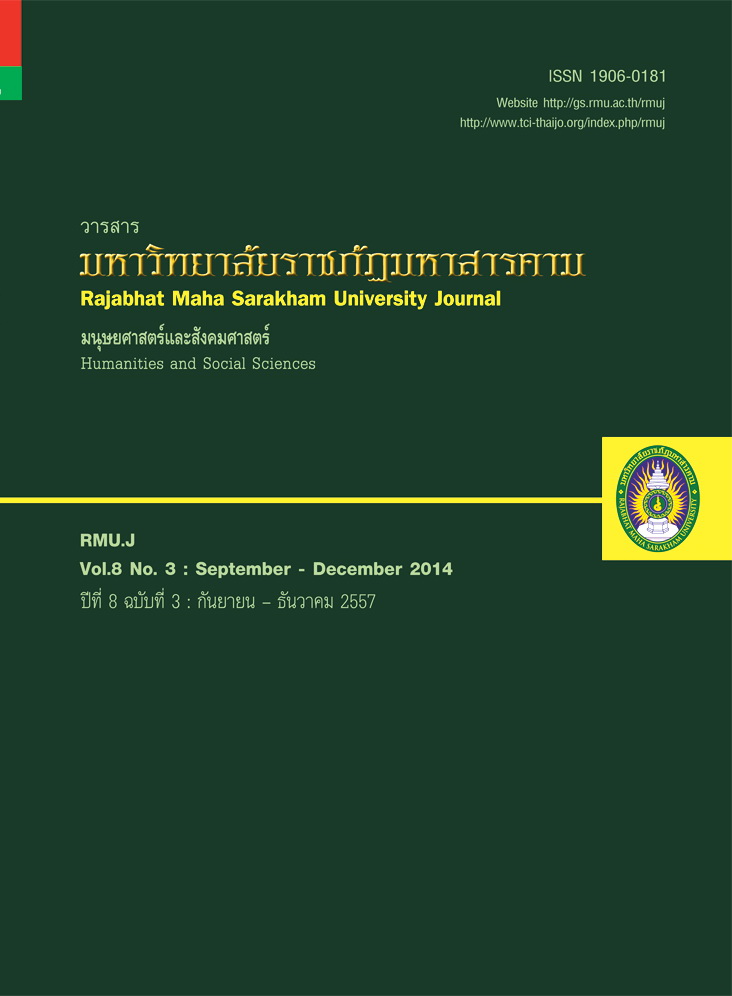การพัฒนารูปแบบการสอนสันติศึกษาในสถาบันอุดมศึกษาไทย Instructional Model Development of Peace Studies in Thai Higher Education Institutions
Main Article Content
บทคัดย่อ
การวิจัยในครั้งนี้มีวัตถุประสงค์ ประการแรก เพื่อศึกษาแนวทางการสอนสันติศึกษาในมหาวิทยาลัยของรัฐและมหาวิทยาลัย
เอกชน สถาบันอุดมศึกษาไทย และประการที่สอง การพัฒนารูปแบบการสอนสันติศึกษา วิธีการสอนสันติศึกษาในมหาวิทยาลัยของ
รัฐและมหาวิทยาลัยเอกชน สถาบันอุดมศึกษาไทย โดยใช้ระเบียบวิธีการวิจัยและพัฒนา (Research and development) ดำเนินการ
วิจัย 4 ขั้นตอน ได้แก่ ขั้นตอนที่ 1 (R1) การวิจัยเอกสาร การสัมภาษณ์ผู้เชี่ยวชาญ อาจารย์ผู้สอนสันติศึกษา และการสังเกตแบบมีส่วน
ร่วม ขั้นตอนที่ 2 (D1) การพัฒนารูปแบบการสอนสันติศึกษา ขั้นตอนที่ 3 (R2) การทดลองใช้รูปแบบการสอนสันติศึกษา และขั้นตอน
ที่ 4 (D2) การปรับปรุงรูปแบบการสอนสันติศึกษา กลุ่มผู้ให้ข้อมูลแบ่งออกเป็น 3 กลุ่ม ซึ่งใช้การเลือกแบบเฉพาะเจาะจง คือ
1) ผู้เชี่ยวชาญสันติศึกษา จำนวน 20 คน 2) อาจารย์ผู้สอนสันติศึกษา จำนวน 9 คน และ3) กลุ่มทดลอง ได้แก่นักศึกษารายวิชาการ
แปลงเปลี่ยนความขัดแย้งโดยสันติวิธี มหาวิทยาลัยมหิดล และรายวิชาการจัดการความขัดแย้งในชีวิตประจำวัน สถาบันการจัดการ
ปัญญาภิวัฒน์จำนวน 113 คน เครื่องมือที่ใช้ในการวิจัย คือ แบบสัมภาษณ์เชิงลึก แบบบันทึกการสังเกตแบบมีส่วนร่วม แบบบันทึก
ประสบการณ์การเรียนรู้ แบบบันทึกการสนทนากลุ่ม และแบบประเมินผลผู้เรียน การวิเคราะห์ข้อมูลใช้สถิติบรรยายเชิงพรรณนา
ค่าเฉลี่ย ส่วนเบี่ยงเบนมาตรฐาน ค่าร้อยละ และค่าสถิติทดสอบที ผลการวิจัยพบว่า
1. ผลการศึกษาแนวทางการสอนสันติศึกษาในสถาบันอุดมศึกษาไทย พบว่า การสอนสันติศึกษาควรมีรูปแบบการสอนแบบ
บูรณาการที่มุ่งเน้นการสอนคุณสมบัติ “สันติภายใน”แก่นักศึกษา เพื่อนำไปสู่การเกิด “สันติภายนอก” และพบปัจจัยที่ส่งผลต่อการ
จัดการเรียนการสอนสันติศึกษาในสถาบันอุดมศึกษาไทย จำนวน 3 ปัจจัย ได้แก่ 1) ปัจจัยภายใน ได้แก่ คุณสมบัติ “สันติภายใน” ของ
นักศึกษา 2) ปัจจัยภายนอก ได้แก่ อาจารย์ผู้สอนสันติศึกษา กิจกรรม รูปแบบ วิธีการหรือกระบวนการในการจัดการเรียนการสอน
3) ปัจจัยเกื้อหนุน ได้แก่ บรรยากาศสภาพแวดล้อมและโครงสร้างทางการศึกษา
2. รูปแบบการสอนสันติศึกษาในสถาบันอุดมศึกษาไทยที่วิจัยและพัฒนาขี้นเรียกว่า “PEACE model” มี 11 องค์ประกอบ
สำคัญ คือ 1) หลักการ 2) วัตถุประสงค์ 3) เนื้อหาการสอน 4) วิธีการสอน 5) ขั้นตอนการสอน 6) สื่อการสอน 7) การประเมินผล
8) บริบทที่เกี่ยวข้อง 9) ระบบการสนับสนุนและการพัฒนา 10) บทบาทอาจารย์ผู้สอน ผู้เรียน และวิทยากร และ 11) เงื่อนไขการนำไป
ใช้ผลการทดลองใช้รูปแบบการสอนสันติศึกษาในสถาบันอุดมศึกษาไทยพบว่า กลุ่มทดลองมีความรู้ด้านสันติศึกษาหลังเรียนสูงกว่าก่อน
เรียนอย่างมีนัยสำคัญทางสถิติที่ระดับ .01 ส่วนเจตคติต่อวิชาสันติศึกษา และนักศึกษามีความพึงพอใจต่อรูปแบบการสอนสันติศึกษา
ในสถาบันอุดมศึกษาไทยโดยภาพรวมอยู่ในระดับมาก และความสามารถในการจัดการความขัดแย้ง โดยภาพรวมอยู่ในระดับปานกลาง
และผลการถอดบทเรียนการสนทนากลุ่มเพื่อการพัฒนาปรับปรุงรูปแบบการสอนสันติศึกษา อาจารย์ผู้สอนสันติศึกษาได้รับรองรูปแบบการสอนสันติศึกษาในสถาบันอุดมศึกษาไทย และมีความพึงพอใจต่อรูปแบบการสอนสันติศึกษาในสถาบันอุดมศึกษาไทยทุกขั้นตอน
ของการจัดการเรียนการสอนโดยภาพรวมอยู่ในระดับมาก
The objectives of this research were to 1) study instructional peace studies in Thai higher education
institutions and 2) develop an instructional model for peace studies in Thai higher education institutions,
named “PEACE Model.”
The research methods were comprised of four phases : Phase 1 (R1): documentary research-in-depth
interviews and participant observation. Phase 2 (D1): research and development of an instructional model
for peace studies. Phase 3 (R2): test the instructional model for peace studies in the classroom. Phase 4 (D2):
adjust, improve, and further develop the instructional model for peace studies. The informants, selected by
purposive selection, were divided into three groups: 1) participants interviewed in depth and observed by
twenty experts. 2) participants interviewed in depth and observed in focus groups by nine teachers. 3)
participants tested the instructional model for peace studies with 113 students in the “Conflict Transformation”
course at Mahidol University and the “Conflict Management in Daily Life” course at Panyapiwat Institute of
Management.
The research instruments included an in-depth interview record, a participant observation record, an experiential
learning journal record, a focus groups record, and an evaluation form of student characteristics. The data
was evaluated, focusing on content analysis, mean, standard deviation, percentage, and t-test dependence.
The results of the research were as follows:
1. The integration instructional model for instructional peace studies focused on teaching inner peace
within the students, taking external factors into account. The following variables affected the course: 1) internal
factors: the students’ inner peace; 2) external factors: peace studies instructors, activities, models, and
teaching procedures; 3) supporting factors: atmosphere and educational structure.
2. The results determined that the developed instructional model for peace studies, PEACE Model,
consists of eleven major components: 1) principle, 2) objective, 3) teaching content, 4) teaching means, 5)
teaching stages, 6) instructional media, 7) evaluation, 8) related context, 9) support development system, 10)
role of instructors, students, and experts, and 11) related conditions.
Results showed that the experimental group felt a level of peace in the post-test evaluation over the
pre-test evaluation by 0.01. Moreover, the students’ satisfaction was “High” with the instructional model for
peace studies and “Average” with the abilities of conflict management. Furthermore, the focus groups and
the instructors of peace studies were both satisfied with the model at a “High” level and accepted the
instructional model for peace studies in Thai higher education.
Article Details
1. บทความที่ลงตีพิมพ์ทุกเรื่องได้รับการตรวจทางวิชาการโดยผู้ประเมินอิสระ ผู้ทรงคุณวุฒิ (Peer Review) สาขาที่เกี่ยวข้อง อย่างน้อย 3 ท่าน ในรูปแบบ Double blind review
2. ข้อคิดเห็นใด ๆ ของบทความที่ลงตีพิมพ์ในวารสารมหาวิทยาลัยราชภัฏมหาสารคาม นี้เป็นของผู้เขียน คณะผู้จัดทำวารสารไม่จำเป็นต้องเห็นด้วย
3. กองบรรณาธิการวารสารมหาวิทยาลัยราชภัฏมหาสารคาม ไม่สงวนสิทธิ์การคัดลอกแต่ให้อ้างอิงแสดงที่มา


